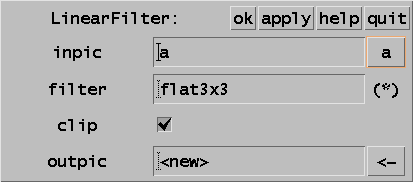introduction
A test version of imp++ is now available. You start it with the command imp++. Imp++ is still in its infancy, and very few functions are supplied in the current (991004) version.Before starting imp++ you should copy the file /usr/local/lib/Imp++/IMP++ to your home directory (or make the X server aware of the file in some other way - linking /usr/lib/X11/app-defaults/IMP++ or setting either of XAPPLRESDIR or XENVIRONMENT).
running imp++
From the user's point of view, imp++ is very similar to imp. One difference is how the windows that are used to define function parameters work: imp++ can handle several simultaneous such windows (and any number [HAHA] of interactions like region editing and contrast/brightness can execute simultaneously as well). An example of a parameter window (this one is for LinearFilter):

creating and using add-ons
Unlike old imp, imp++ uses dynamic linking, at run-time, of functions (apart from those that are supplied with imp). So if you write your own functions or use packages written for imp++, dynamic linking will be used. One consequence of this is that you can write a function, add it to a library, start imp++, test the function, rewrite it, and test the new version without terminatig imp++. And there is no need for an imp++ of one's own anymore.Like imp, imp++ reads your function declarations at start-up, but imp++ can read many different declaration files. Use the environment variable IMPMODDIR to define directories where the declaration files (called "impmodfunctions.h") are located. IMPMODDIR is like PATH, so directories are separated by a semicolon.
For those who have written C functions for imp and for those unfortunate souls who persist in doing so: imp++ tries to stay compatible with imp so most of your old imp functions should work almost without modification: the exceptions are
- Feature calculations - not yet implemented in imp++, but the programmer's
interface will change drastically, so your old functions will have to be
rewritten.
Solution: Undefined... - The infamous ENUM variables have been mercifully put to sleep and
replaced by "integers with keywords".
Solution: replaceENUMwithINTand add keywords (KEYWORD(1,"Ett") KEYWORD(2,"Två"), etc) instead. And replaceENUMVALUE ( *aa)with the much simpler*aain the C code. - The keyword
TEMPORARY(for images or region sets that were invisible to the interface) has been - at least temporarily - removed.
Solution: write a very simple C++ interface function - I will provide examples. - The old way of allocating memory for images in the Wh... functions does
not work anymore (more to the point: you can allocate memory but imp++ will
no nothing about it).
Solution: write a very simple C++ interface function - I will provide examples.
setenv IMPMODDIR /usr/local/lib/Imp++/Fred
and FilterEditor will be added to the menu bar of imp++ (under Special).
The directory /usr/local/lib/Imp++/Additions contains what is
needed to
get started writing imp++ functions - or adding old imp functions to imp++:
a Makefile, example C++ (imptest.C) and C files (whcanny.c and
whbandaverage.c), declarations of the functions (impcppfunctions.h
and impcfunctions.h). The Makefile uses the program impctocpp to "translate"
(i.e., create the necessary functions in cfuncs.C) from C to C++. As mentioned
above, imp++ reads declarations in impmodfunctions.h: this file is created
by the Makefile if either of impcppfunctions.h or impcfunctions.h has
changed. The first line in impmodfunctions.h
- USING ("myimplib.so"); - informs imp++ about the name of the
library file.
plans for the immediate future
In the next couple of weeks, I intend to bring the functionality of imp++ close to that of imp. Old imp functions will be added and I will probably rewrite most functions that involves interactive image manipulation.One important reason why this test version is made available is that I want feedback from other users than myself. I am aware of quite a few bugs in imp++, but please report any bugs and quirks you encounter.
I will add information (any kind: bugs, corrected bugs, new test releases, ...) here - there will probably be no other sources of information about the progress of imp++ ...
what's new?
- 991117: added information about how to plug in plug-ins (in latest news)
- 991013: updated version: some new functions, image handler, corrected a few bugs in Fred.
- 991004: info: don't try impish just yet (for you own good)
- 991004: first test version
- 991003: The menu Binary is new; it contains regionset manipulation functions: regionset in, regionset out.
- 991003: median image does not always work
- 991003: map (image) as display doesn't work
- 991003: don't know about FFT ??
- 991003: no pop-up image handler yet, some of the functions that will end up there are temporarily placed under Display.
- 991003: Test contains "debugging tools" (
typevar) and a few of my test functions (for testing the innards of imp++) - 991003: No Help I'm afraid.
Last modified: Wed Nov 6 11:58:21 MET 2002 by Bo Nordin